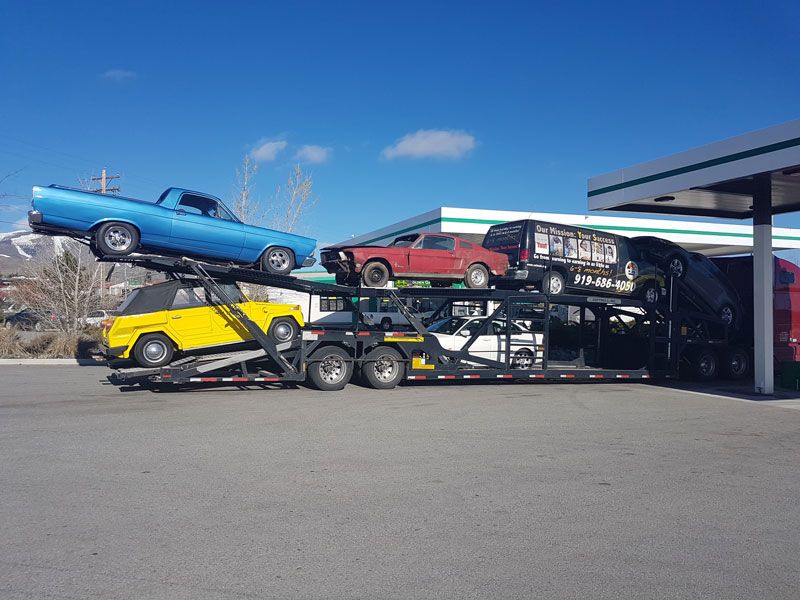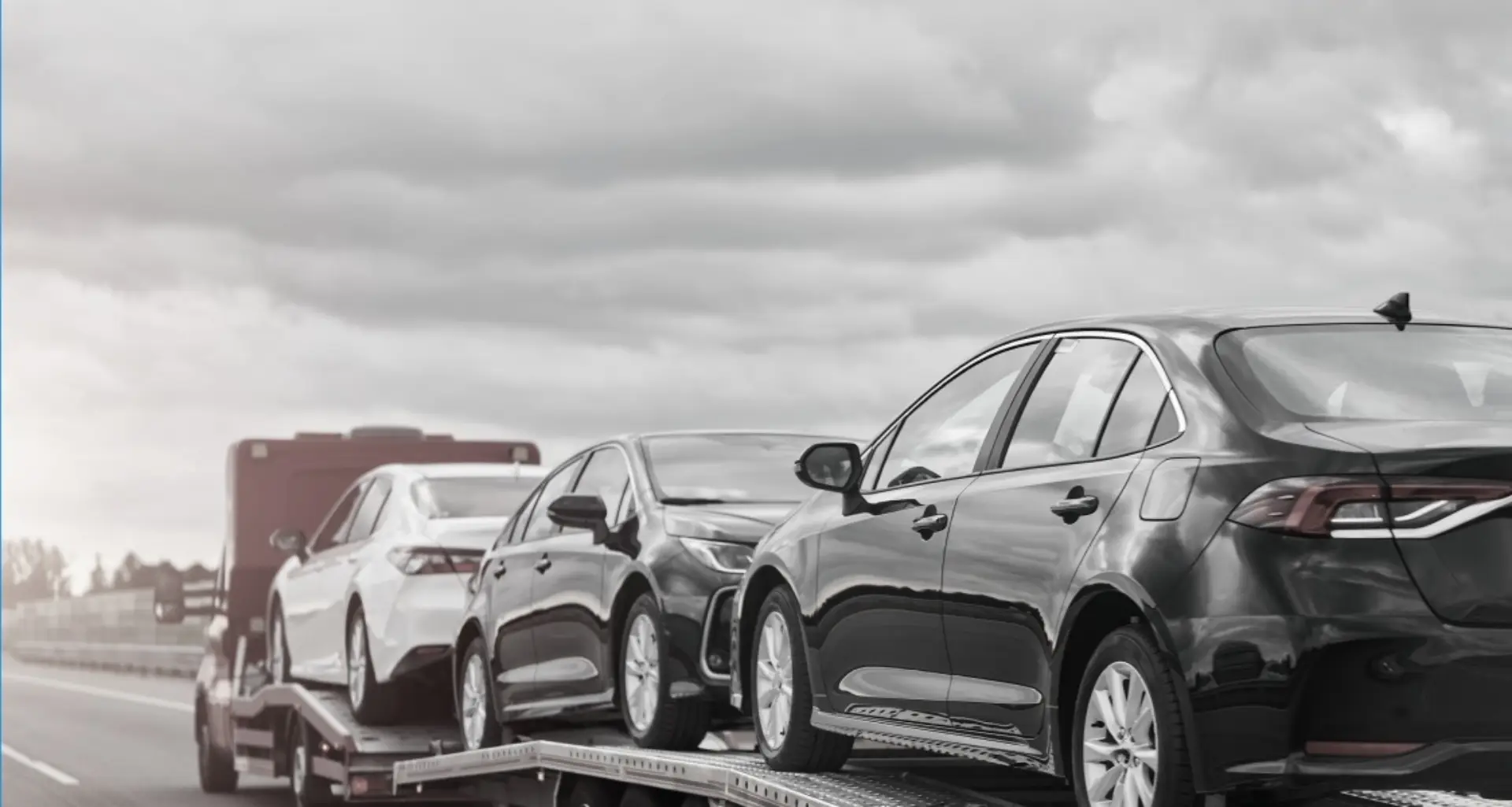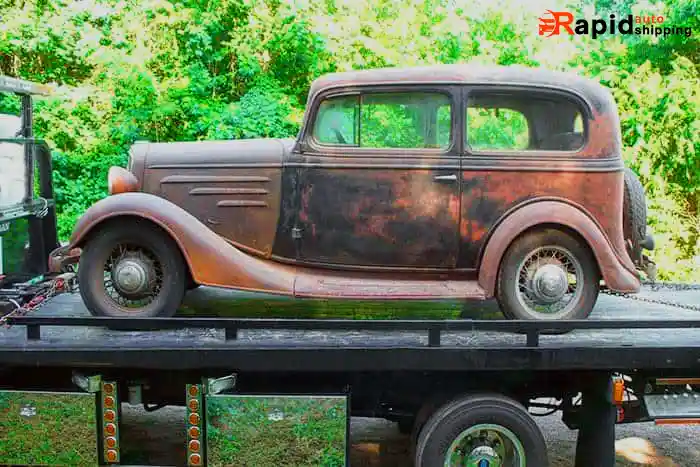
Non-Running Vehicle Transport: Shipping Inoperable & Damaged Cars Safely
Non-running vehicle transport refers to the shipping of vehicles that do not function, operate, are disabled, or are damaged. Shipping a non-running car or vehicle requires special equipment and training to be moved on and off the carrier. You may have won a non-running dream car at an online auto auction, or you may have a disabled car that needs to be sent to a collision center. Inoperable vehicle transport is the answer to this. It is usually carried out by open transport; however, enclosed transport is preferred in some cases. At Rapid Auto Shipping, we provide expert transport services for non-running, damaged, and inoperable vehicles. Explore options for damaged vehicle transport and salvage car shipping today!
Guide to Non-Running Vehicle Transport and Inoperable Car Shipping
Non-running vehicle transport requires moving a vehicle that cannot move under its own power, needing specialized equipment and methods like winching, forklifts, or ramps under the operation of skilled and trained personnel for loading and unloading. Vehicles may become inoperable due to various reasons such as engine issues, broken steering, or missing parts.
When someone purchases a classic car that needs restoration or a salvaged car is required to be relocated from their current location to a place where they can be either stored, auctioned, repaired, or dismantled for parts, or a moving broken-down vehicle requiring to sent to repairs center Inoperable vehicles, which includes cars that cannot roll such as heavily damaged vehicles or vehicles that are used for parts, low clearance vehicles, rare classic vehicles, and more.
Even if the vehicle you want to transport does not have wheels, all that it needs is reputable and experienced transport shipping handlers, since moving this type of vehicle needs a lot of care and expertise. Experienced and professional shipping companies can handle this transportation with their trained and professional personnel.

Non-Running Vehicle Transport
Understanding Non-Running Vehicle Transport
A non-running car refers to a vehicle that is unable to start or operate its engine, typically due to mechanical issues or a lack of necessary parts. This means that it cannot be driven because of a broken engine, transmission problem, or issues with vital components. A non-running car can have a dead battery, faulty wiring, a malfunctioning ignition system, or problems developed during a restoration project. Such vehicles require special equipment and training to be moved on to and off the carrier with the help of winches, forklifts, flatbeds, and specialized ramps.
The challenges presented in this field may vary in nature. They may be like properly securing loose parts, addressing potential fluid leaks, ensuring the vehicle is stabilized during transport, and complying with specific documentation requirements. To ensure the safe and reliable shipping of a non-running car or vehicle, it is important to find a qualified auto transporter.
Most auto transporters hauling salvage vehicles have the necessary equipment and knowledge to handle them properly. By entrusting your non-running vehicle transport to professionals, you can have peace of mind knowing it will be treated with care throughout the transportation process.
Key Considerations for Shipping a Non-Running Car
Shipping a non-running car requires careful planning, including choosing a reputable company with experience in handling such vehicles, ensuring adequate insurance, and understanding potential costs and specialized equipment needed for loading and unloading.
Choosing The Right Auto Transport Company
Shipping companies that specialize in non-running vehicle transport are ideal for handling such delicate shipments. Inquire about their methods of loading and unloading, such as winches, forklifts, or specialized ramps. Obtain a detailed quote outlining all costs, including potential fees for non-running vehicles. The company should provide adequate liability insurance.
Vehicle Preparation
Ensure to empty all personal items from the car, as these are not allowed to be transported with the vehicle. The vehicle should be free from any fluid leaks that could cause problems during transportation. Items, such as racks, antennas, spoilers, or any other external attachments or accessories, should be removed to prevent damage during transit.
Transport Options
Both open and enclosed transportation can handle a non-running vehicle, but enclosed transport offers better protection for valuable or sensitive vehicles. A flatbed truck can be considered for vehicles that have non-functional wheels or have low clearance to facilitate loading and unloading.
Cost Factors
The cost of shipping depends directly on the distance to be covered. The summer and winter seasons increase the cost as the services are more in demand than in other seasons. The need for specialized equipment and handling of inoperable vehicles can lead to higher costs.
Inoperable Vehicle Transport: What You Need to Know
An inoperable vehicle is a vehicle that is unable to function as intended. These vehicles are typically rendered inoperable due to various factors, including mechanical issues, missing essential components, extensive damage, age-related deterioration, or legal compliance concerns, making them unsuitable for safe and effective use on public roads. These vehicles require substantial repairs, restoration, or legal adjustments to regain their operational status and roadworthiness.
An inoperable vehicle can be a Project car purchased for customization or restoration, a Junk car vehicle at the end of its life and can't be used, or a salvaged vehicle that has met with an accident and needs repair, resale, or dismantling. It can be a Classic car that is non-operational due to age or mechanical issues, or a collector's car that is transported for display, maintenance, or restoration. They may be impounded cars going to impound lots or auction sites, or Off-road vehicles like ATVs and dirt bikes that have become inoperational and need repair or resale.
An IN-OP vehicle needs special procedures and expert handling due to its inoperable state. It may have missing keys, flat tires, inoperable brakes, faulty wiring, a malfunctioning ignition system, and many more such issues. Due to this, inoperable vehicle transport companies use specialized equipment like winches, forklifts, and specialized ramps for loading and unloading the vehicle.
This prevents the car from further damage and any losses that may arise due to faulty handling. However, the use of specialized equipment and procedures may result in higher transportation costs compared to the standard shipping costs, but this becomes necessary considering the nature of the shipment.
Sometimes, the vehicle may have some delicate or sensitive parts that need protection from harsh weather and dust. In this scenario, enclosed transportation is preferred, which can again be costlier than open or standard shipping.
How Inoperable Vehicle Transport Differs from Standard Shipping
Inoperable vehicle transport differs from Standard transport because it involves vehicles that cannot be driven onto a carrier, requiring specialized methods like winching or forklifts for loading and unloading purposes, whereas standard transport involves vehicles that can be driven onto a carrier. However, several other factors differ in the inoperable vehicle transport from standard transport. They may be.
Carrier type
Sometimes, an enclosed carrier is necessary for inoperable transport, but standard shipping can be carried out on an open transport method.
Cost
Inoperable shipping involves the use of specialized equipment and labor trained specifically for it, but standard shipping may not require such equipment or labor, which reduces the cost of standard shipping.
Specialized companies
Some companies specialize in inoperable transport services, whereas standard transport companies are not specialized in carrying out such shipping.
Insurance and Bonding
It's crucial to choose a transport company with bonding, appropriate Insurance, and Department of Transportation registration to ensure secure and skilled handling in case of inoperable shipping.
Damaged Vehicle Transport: Handling Salvage Cars
Salvage cars are vehicles that have been declared a total loss by the insurance company as it has become unfit to drive due to accidents, natural disasters, or other incidents. Vehicles that have been damaged to the extent that the cost of repairs exceeds their original value are salvaged or totaled vehicles. These vehicles are sold and purchased for various purposes and are transported from their current location to a place where they can be either stored, auctioned, repaired, or dismantled for parts.
An expert in salvage vehicles uses it for the restoration of other vehicles, or he can use the parts of another vehicle to turn it into a very useful remodeled vehicle. Depending on the extent of the damage, handling and loading of salvage cars may require special expertise and equipment to prevent further damage and safely move them from one location to another.
Shipping companies have trained and qualified staff to handle such vehicle transport. Salvage car transporters use special equipment and training to move the vehicle onto and off the carrier with the help of winches, forklifts, flatbeds, and specialized ramps. The challenges presented in this field may vary in nature. They may be like properly securing loose parts, addressing potential fluid leaks, ensuring the vehicle is stabilized during transport, and complying with specific documentation requirements.
Tips for Safe Damaged Vehicle Transport
Assessing The Vehicle's Condition
The condition of the vehicle must be assessed from both inside and outside. Find out whether the vehicle rolls, steers, or brakes. Any loose parts should be secured inside the vehicle, as these may detach during delivery. Any leaks of fuel or oil should be addressed before transportation begins.
Preparing The Pickup Location
The pickup site should have the necessary tools to load the vehicle. Loading assistance, like forklifts, winches, and flatbeds, will be needed if the vehicle is inoperable.
Preparing The Delivery Location
Unloading preparations should be as good as the loading. The delivery point should have sufficient space and appropriate instruments for unloading. An alternate delivery plan should be kept ready if a delivery option fails.
Selecting A Reliable Transport Carrier
An experienced auto transport carrier should be selected for salvaged vehicle shipping. They should excel in handling inoperable vehicle transport. Detailed information about the vehicle's condition should be provided to the carrier to ensure they bring the right instruments.
Safety And Documents Verification
All required documents, including the proof of ownership and salvage title, should be kept in order before vehicle transportation. Double-check for any remaining loose parts and fluid leaks. Take photos of the vehicle to document its condition before transporting it.
Choosing the Right Service for Shipping a Non-Running Car
When choosing a service to ship a non-running car, prioritize companies experienced in handling such vehicles, ensure adequate insurance coverage, and get a detailed quote outlining all costs upfront. Here's a more detailed breakdown:
Experience
Look for companies that specialize in transporting non-operational vehicles and ask about their equipment and procedures for loading and unloading.
Insurance
Verify that the carrier has adequate liability insurance and consider supplemental insurance, especially for valuable vehicles.
Cost Transparency
Obtain a detailed quote that clearly outlines all costs, including potential fees for non-operational vehicles, and discuss these costs upfront.
Loading and Unloading
Discuss how the car will be loaded and unloaded, as this might involve using winches or forklifts.
Open vs. Enclosed Carriers
Consider the type of carrier, with open carriers being more common and affordable, while enclosed carriers offer superior protection.
Shipping Methods
Explore options like container shipping for added security or roll-on/roll-off (RORO) transport for wheeled cargo.
Cost Factors in Inoperable Vehicle Transport
The cost of shipping an inoperable vehicle is influenced by various factors. Distance of transport directly influences the cost of transportation; the longer the distance, the higher the cost. The cost of a vehicle increases during the peak summer and winter seasons, whereas it decreases during other seasons. Vehicle year, make, and model also significantly vary the cost of transportation; smaller cars cost less for transportation than the larger and heavier ones. Inoperable vehicle costs may be higher depending on their mobility, as these require the use of specialized equipment and labor. Transport method (open or enclosed) Open car transport for inoperable vehicles will cost significantly less than an enclosed transport option. Any additional services required (e.g., guaranteed pickup) may result in a higher cost of transporting such vehicles.
Step-by-Step Process for Inoperable Vehicle Transport
Get a quote by providing vehicle details
Start by obtaining a quote from Rapid Auto Shipping for your salvage car shipment. Provide accurate vehicle details, including the make, model, year, and specific information about the car's salvage condition. Be sure to note if the vehicle is inoperable, as this will be a significant factor when it comes to pricing and finding the best transporter to meet your needs. Keep in mind that if the vehicle does not roll, brake, or steer, you will need to contact us for a custom quote at 833-233-4447.
If the vehicle is coming from a salvage auction, the carrier will have to work with the location to arrange pickup from their facility. In these cases, please make sure to provide your shipper with all the vehicle information, including the VIN, buyer number, low number, and stock number.
Pickup, transport, and delivery
Once a carrier has been assigned to your shipment, and on your arranged pickup date, your vehicle will be picked up at an agreed-upon location where it will be securely loaded onto a trailer or flatbed. From there, it will depart for your specific destination. Upon delivery, the vehicle will be unloaded for a final inspection.
Preparing Your Vehicle for Shipping
Maintenance Check
Your vehicle must be fully operational and able to roll, brake, and steer under its own power. However, it may not be relevant in the case of an inoperable vehicle.
Exterior Parts
Retract or remove your antenna and place it in your truck, remove your bike rack, and any loose parts.
Wash Your Car
Just a quick bath, no detailing needed! It's easier for you and the trucker to inspect your car for any scratches, dents, etc. You'll sign the Bill of Lading (BOL) with this inspection at pickup and delivery.
Personal Items
You're allowed one piece of luggage (suitcase, box, duffel bag) up to 100 pounds in the trunk or storage area (below window level) during transport.
Have Keys Ready
The truck driver will need keys to drive your vehicle on and off the truck.
Remove Valuables
To ensure your valuable items stay safe, remove vehicle add-ons such as custom stereos, GPS systems, etc.
Gas Tank
Make sure your gas tank is about ¼ full. A full tank adds weight to your vehicle and the car carrier. We prefer that electric vehicles have a fully charged battery and charging cables, but these are not applicable in case of an inoperable vehicle.
Parking Passes/Toll Tags
Remove them to avoid fees as your car passes through tolls.

0 Yr
In the business
0K
Quotes
0K
Vehicles Shipped
0.0/5
Overall Rating
Conclusion
Shipping a non-running car or inoperable vehicle is possible, but typically more expensive and complex than transporting a running vehicle. This is due to the fact that inoperable vehicle transport is the job of an experienced damaged vehicle transport company that employs very skilled, organized, and experienced personnel and involves the use of special equipment and techniques.

Everything you need to know about our auto transport services
Yes, Rapid Auto Shipping specializes in transporting non-running and inoperable vehicles using professional carriers equipped with winches, lift gates, or forklifts.
Depending on the condition, we use winches, flatbeds, or specialized equipment to safely load your non-operational vehicle without causing damage.
Yes, slightly. The cost is higher due to additional labor and equipment required. Request a free quote for accurate pricing based on your vehicle's condition and distance.
Absolutely. We can transport vehicles in any condition, even those that don't roll, brake, or steer. Just provide accurate details when booking.
Yes. Your non-running vehicle is fully insured during transit, and you'll receive inspection documentation before and after the shipment.
Simply fill out our online quote form or call us directly. We'll provide a custom quote and arrange everything from pickup to delivery.